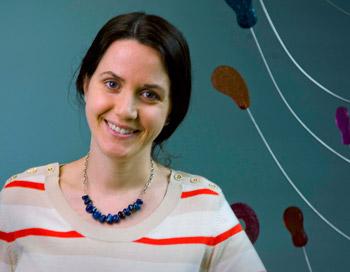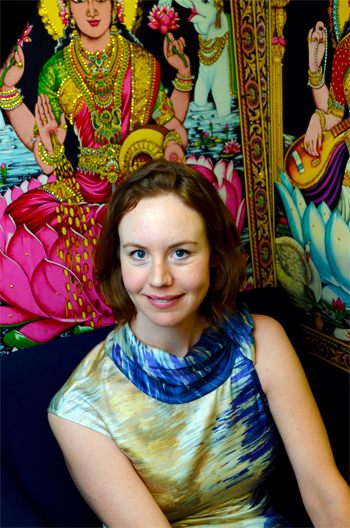 Rhonda Hauser, Director of the Lab SchoolThere are four places set at a tiny table in the classroom for 4-year-olds at the Priscilla Pond Flawn Child and Family Laboratory (affectionately known as the Lab School). Each place setting includes a shallow blue plastic bucket arranged on top of a folded bath towel.
Rhonda Hauser, Director of the Lab SchoolThere are four places set at a tiny table in the classroom for 4-year-olds at the Priscilla Pond Flawn Child and Family Laboratory (affectionately known as the Lab School). Each place setting includes a shallow blue plastic bucket arranged on top of a folded bath towel.
The buckets are filled with a soupy mixture of corn starch and water. Children cluster around the table. The prospect of scooping cool handfuls of white glop, of diving in up to the elbows, is irresistible.
There are 16 children in the class; there are only four places at the table.
The children will have to navigate a complex and nuanced social situation to find a place at the table.
Who goes first? Second? How long is a turn? What happens if a turn is missed?
If there is to be order and fairness, there are rules to be followed, boundaries to be respected. The unspoken expectations are inherent to the table’s arrangement, and this entire activity has been carefully orchestrated by the Lab School’s master teachers, who serve as guides while the children sort out the complexities.
“Children learn best by doing, by exploring and manipulating their worlds,” says Rhonda Hauser, director of the Lab School. “We focus on building an environment to prepare children to succeed academically but also to build a strong sense of self, to develop the ability to embrace new challenges, and to be active problem solvers. We want children to be prepared to succeed.”
Theory to Practice
It’s not just the children who are learning by doing. The Lab School, which enrolls 105 children between ages 18 months and 6 years, affords undergraduates at The University of Texas at Austin an opportunity to observe how young children interact and to see the theories they learn in the classroom in action on the playground.
Scattered around the Lab School’s classroom for 3-year-olds are undergraduate students from Ted Dix’s honors Child Development class, each recording observations.
The undergraduates are conducting a research project to determine whether, at early stages in human development, the same children who engage in altruistic and pro-social behaviors can also be aggressive and dominant, often shifting between the two.
With 13 undergraduate students are building a data set that includes 130 hours of observation coded to evaluate statistically altruistic and aggressive behavior in 3- and 4-year-olds.
“The Lab School gives our students an opportunity to start thinking like social scientists. They have the opportunity to design and implement a small research study that will connect the theories about how personality and social behavior emerge in young children,” Dix says.
Putting the “Lab” in Lab School
The Lab School supports the research of faculty members across disciplines. Faculty members from education, psychology, kinesiology and human development often use the Lab School for pilot studies intended to eventually examine a broader population. The pilot approach allows researchers to tweak methods and troubleshoot potential problems before embarking on larger-scale work.
 Marci Gleason, assistant professor in Human Development and Family SciencesOne such study is Marci Gleason’s Daily Living Project. Gleason, assistant professor in Human Development and Family Science, is interested in how parents’ relationships with their children affect their relationship with each other.
Marci Gleason, assistant professor in Human Development and Family SciencesOne such study is Marci Gleason’s Daily Living Project. Gleason, assistant professor in Human Development and Family Science, is interested in how parents’ relationships with their children affect their relationship with each other.
She is also exploring how major life transitions — couples expecting the birth of their first child, for example — affect overall couple functioning and relationship satisfaction.
Using the Lab School’s waiting list to locate expectant mothers in their third trimester, Gleason and her team piloted a study that was expanded to include the Austin community.
“We started with a focus group of Lab School parents. The Lab School opened their rooms to us; we were able to have two focus groups. We had undergraduate research assistants in the booths listening to our discussion,” Gleason says.
The support provided by the Lab School enabled her to develop a daily diary questionnaire that became integral to her study.
The mothers-to-be and their partners were loaned iPod Touch devices to respond to the questionnaire and to report on their daily activities and moods. This data was collected for three weeks in the third trimester and again at 9 weeks and 14 months postpartum.
“We know that having a child, particularly a first child, is a significant transition in a family. It’s a positive transition, but it’s still a stressor. We are interested in taking a snapshot of couple interactions and couple functioning before and after a major life transition,” Gleason says.
The study is now entering its final round of data collection, and the results will be published soon.
“The Lab School gave me a place to start” Gleason says.
The Child and the Scientist
 Cristine Legare, assistant professor in the Department of PsychologyCristine Legare, assistant professor in the Department of Psychology, is interested in identifying the moment in the process of discovery and learning that gives rise to the acquisition of scientific reasoning. At what moment does a child begin to develop hypotheses?
Cristine Legare, assistant professor in the Department of PsychologyCristine Legare, assistant professor in the Department of Psychology, is interested in identifying the moment in the process of discovery and learning that gives rise to the acquisition of scientific reasoning. At what moment does a child begin to develop hypotheses?
To answer this question, Legare developed an experimental situation involving a “discovery box,” a device containing a small light. When an object is placed on the discovery box, the light comes on. After a research assistant demonstrates how to make the discovery box work, preschool children quickly grasp what will make the mechanism light up.
Children are then presented with an experimental situation: One of the discovery boxes will not light up when an object is placed in the expected position; this is a moment when the unexpected happens.
Children quickly ignore expected results; it’s the unexpected result that draws children’s attention.
Legare says, “When faced with an unexpected outcome, the children begin to generate hypotheses. If we give them access to the boxes, children develop tests for their hypotheses. They spontaneously develop six or seven tests — such as flipping the box over, restacking objects and opening objects — in an attempt to find the causal mechanism.”
The scientific reasoning process begins with surprise. “We are interested in finding how this process develops in young children. We can then work to harness the power of curiosity and spontaneous discovery.”
The Priscilla Pond Flawn Child and Family Laboratory is housed in the Sarah M. and Charles E. Seay Building and is affiliated with the Department of Human Development and Family Sciences


















Comments